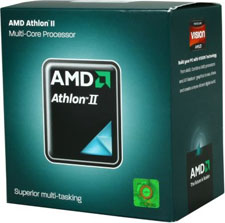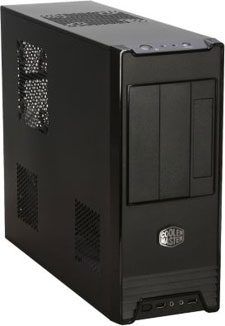Holiday 2010 System Builder's Guide
by AnandTech Staff, edited by Jarred Walton on November 19, 2010 2:00 AM EST- Posted in
- Guides
- Systems
- Holiday 2010
| Dustin's AMD Pure Budget System | ||
| Hardware | Component | Price |
| Processor |
AMD Athlon II X4 640 (Propus 45nm, 3.0GHz, 4x512KB L2, 95W) |
$99 |
| Video | Integrated ATI Radeon HD 4250 | - |
| Motherboard | MSI 880GM-E41 (AMD 880G/SB710 AM3) | $75 |
| Memory | Corsair 4GB (2x2GB) DDR3-1333 CL9 (CMV4GX3M2A1333C9) | $59 |
| Hard Drive |
Samsung Spinpoint F3 500GB (HD502HJ 7200RPM 16MB) |
$40 |
| Optical Drive | LG 22X DVDRW (GH22LS50) | $17 |
| Case | Cooler Master Elite 360 | $40 |
| Power Supply |
Antec EarthWatts Green EA-380D 380W (380W 80 Plus Bronze Certified) |
$45 |
| Base System Total | $375 | |
Over the past summer I wound up building a rash of budget systems for friends and family; over the past year you can chalk a couple more up. I actually have about two more queued up for the holiday season, so suffice it to say I keep a list of go-to parts for my builds that I've been consistently satisfied with. For this build I decided to go for a sort of "optimum budget" machine, and with most selections I'll have a suggestion as to how to reduce the price tag without hurting overall quality. There are some compromises made here—note the lack of a video card—but I'm perfectly happy putting my stamp on this system.

The first big decision is the processor, and I want something that'll last. It's true that Grandma Millie may not need all that power, but I've found that the AMD Athlon II X4 has been my go-to for nearly every budget build since its inception; it's just that good of a deal. The price-performance is undeniable and when you can get a quad core for $99, why would you settle for less? If you need to make a deeper cut for users who aren't going to push the system that hard, I've been remarkably impressed by the AMD Sempron 140. It's a 2.7GHz single core, but of the three I've built, two have unlocked into stable dual-cores—i.e. Athlon II X2—and at $33, it's an absolute steal.
Picking the motherboard turned out to be a bit trickier, but I've found myself consistently satisfied with boards from MSI, Gigabyte, and ASUS. After narrowing the brand down, I want an integrated chipset that's going to pass my "Grandma Test:" is it powerful enough to play Hulu and YouTube HD video? That leaves us with the 785G and 880G chipsets, and since those have hit price parity (actually the 880G is cheaper now!), I opted to go with MSI's 880GM-E41. I'm not too thrilled about the SB710 Southbridge, but the lack of 6Gbps SATA isn't devastating. The ATI Radeon HD 4250 integrated graphics part offers enough horsepower to even play the odd game, but mostly it's there for hardware-accelerated video and Flash (with 10.1), which can make a big difference with Hulu. Unfortunately, this is about as low as I'll go; other cheaper integrated chipsets don't bring that acceleration to the table.
As far as memory goes, I'll be blunt here: I only buy Corsair for my own builds. Jarred recommends an A-DATA set on his build and I've been happy with them; the fundamental deal with RAM is this: it either works or it doesn't. The problem is that when RAM is bad, it can be difficult to figure out. I've used Corsair on nearly every build I've done for friends and family and I've seen a whole one bad stick of it. With 2GB kits only shaving maybe $20 off the cost of the build, it's hard to justify not going the full 4GB. If every penny must be spared, I wouldn't be unhappy with this Kingston 2GB (2x1GB) DDR3-1333 kit at $38; in my experience Kingston is another good, reliable brand.
With hard disk prices the way they are, your bottom rung should really be 500GB of storage; the amount you pay for the capacity you get below $50 just isn't worth it. I've also been consistently happy with Western Digital's Caviar Blue drives, but this would be a good time to bring out a new cult favorite: the Samsung SpinPoint F3 1TB drive is stupid fast, and if you know where to look you can usually get it for about $60. For the budget sector, we opted to go with the 500GB model and save $20.

As far as budget cases go, I've been very happy with the Cooler Master Elite 360 and have used it on a few builds; in fact, I actually have one in my house for my media center PC. The Elite 360 isn't built for big, power-hungry builds, but it's usually cool and quiet enough for even a decent gaming machine provided you opt for a video card that will fit in the enclosure. I've elected to pair it with a 380W Antec EarthWatts Green power supply (don't forget the power cord if you don't have extras!); there's enough room to breathe for an efficient video card like an ATI Radeon HD 5770 down the road (which will fit just fine in the Elite 360), and you never want to cheap out on the power supply if you can avoid it.
The rest is going to be a matter of religion and taste. You can get a decent display with (crappy) built-in speakers for a low price. For the operating system, there's always Ubuntu, or you can usually find a good deal on Windows 7 if you know where to look (student discounts are amazing for this). But the build I've specced out here is something I'd be confident with. I've got comparable parts running in machines at home and in the machines of friends and family, and there's been nary a peep from anyone. That should tell you the real value of speccing out a good system from the get-go and not cutting corners on parts: peace of mind, and peace and quiet.










112 Comments
View All Comments
prdola0 - Friday, November 19, 2010 - link
In some of the systems, I would buy a GTX460 1GB instead of the HD6850 simply because most people play in 1920x1200 and lower (I would say 1680x1050 as the most common) and in those resolutions the GTX460 is better than the HD6850. It would be also a choice for the next generation of games, if the consoles ever let it come. Otherwise very nice systems.One question though, are all those memories you guys used from QVLs of the motherboards or do you just trust them?
Thanks a lot,
Prdola
ganeshts - Friday, November 19, 2010 - link
The components suggested in my mid-range HTPC build are all tried and tested together :)therealnickdanger - Friday, November 19, 2010 - link
It would be cool if each of these builds was benched and the results were shown... :) I know that's asking a lot, but like Brian said:"Heck, there's no reason you can't at least ask for the absolute best..."
AnnihilatorX - Saturday, November 20, 2010 - link
I'd personally go for HD6850. It runs cooler, uses less power, can double up as high quality sound card (if you have a AV receiver with HDMI, Radeon HD68xx support DTS Master HD, etc).prdola0 - Monday, November 22, 2010 - link
The GTX460 can of course also double up as a high quality soind card. Why wouldn't it?blotto5 - Saturday, November 20, 2010 - link
for 1680x1050 it does perform better, but not by much. for 1920x1200 there is almost no difference, and for any resolution higher than that the 6850 blows it out of the water. when your have an amd processor and an amd chipset it would make sense to stay on the same platform and get an amd video card, everything plays nice together that way.prdola0 - Monday, November 22, 2010 - link
Any nVidia graphics card will work just as good on an AMD system as on an Intel system. How did you find that it wouldn't? That's totally false.And your statement about no difference in 1920x1200 is only valid for the GTX460 768MB. The 1GB version is actually still better at 1920x1200. According to Steam Survey, 74.2% of players play at 1680x1050 or lower resolution and only 4.19% play at higher resolutions than 1920x1200. I still don't understand why all the reviews focus so much on the 2560x1600 resolution. I wish Ryan didn't ignore that fact in his Final Words. But world isn't perfect :)
Quizzical - Friday, November 19, 2010 - link
If Zambezi isn't going to fit Socket AM3, then someone ought to tell AMD.End of page 5 of the AMD codename decoder that they released on financial analyst day:
“Zambezi”
Market: Desktop
What is it? four-, six-, or eight-core 32-nm AM3 socket desktop processor based on
the “Bulldozer” processor architecture for the enthusiast market.
Planned for introduction: 1H 2011
If I give a link, this site apparently flags the comment as spam and disallows it. But you can find it yourself as follows. Do a Google search for "AMD 2010 Financial Analyst Day". Click the (currently) top search result, to a page on AMD's site with that headline. Click the "AMD Codename Decoder" link from that page. The above is a copy and paste from the end of the document.
Dustin Sklavos - Friday, November 19, 2010 - link
Later on in the year they did say they tried to make Bulldozer compatible with the existing AM3 socket but couldn't do it, as a result you get AM3r2, where the motherboards will be backwards compatible with old AM3 chips, but the Bulldozer chips aren't going to be compatible with old AM3 boards.Quizzical - Friday, November 19, 2010 - link
The information I quoted was released by AMD last week. "Later on in the year" than that would have to be very, very recent. As I said, if the information that AMD just released is wrong, someone should tell them to fix it.